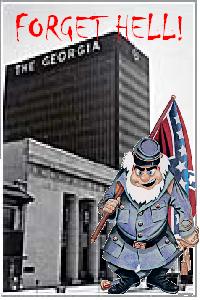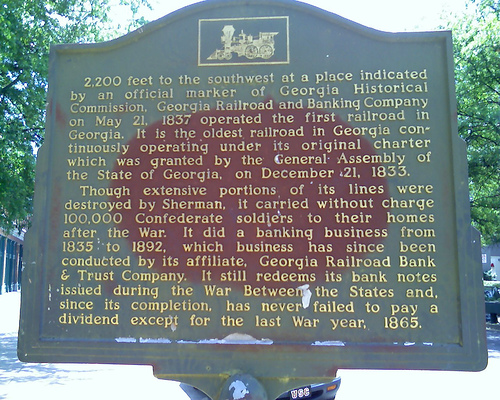
|
Home About This Site Bibliography Contact Us
|
The Georgia Railroad Bank
 Georiga Railroad Bank
Georiga Railroad Bank(Now Wachovia Bank) Broad Street, Augusta, Georgia
"Many times without adequate food or clothing, the Confederate soldier was seldom in need of the essential gunpowder the railroads brought to him from Augusta," The Georgia Railroad Company was chartered to a group of Athens businessmen in 1833 for the purpose of building a railroad from Augusta west into the interior of the state to extend the line that already existed between Charleston, South Carolina, and Augusta. In 1835 the charter was amended to allow banking operations, and the name was changed to Georgia Railroad and Banking Company. The bank had a capital stock of $2 million and issued its own paper money. In 1836, the company purchased land ``on the northwest corner of Broad and McIntosh (Seventh) streets for the banking house. The first train moved out of Augusta on company tracks in 1837. Company headquarters moved from Athens to Augusta in 1840. By 1842, the railroad extended to Madison, and by 1845 to Marthasville - now called Atlanta. That same year the bank branch of the company helped to finance the Augusta canal that brought water-powered industry to the city and fostered its manufacturing rebirth. The company operated continuously during the War for Southern Independence, transporting men and materiel for the Confederate war effort. Company railroads carried nearly all the gunpowder made for the Confederacy from the Confederate Powder Works. At the end of the war, the railroad carried 100,000 southern veterans home free of charge. Large portions of the lines, facilities, and rolling stock were destroyed during the conflict and had to be replaced at war's end. Bank notes issued by the company during hostilities were honored after the war and could still be redeemed at face value as late as the 1980s. Despite the expiration of its charter in 1864, the bank continued to function, and the charter was renewed in 1870.
In 1986, First Union acquired the company. Augusta chronicle cartoonist, Clyde Wells, in his classic cartoon showed the little "forget hell" general standing in front of the bank as the name was changed. Later the bank was acquired by Wachovia which fell all over itself apologizing for its acquisition.
But cheap apologies only dilute authentic shame and genuine remorse. What makes these particular apologies cheap is that none of the apologizers really suggests doing anything more than trying to rewrite history and bask in applause... Only the Lord knows the depth of a man's sincerity in these matters, so we're left to measure as best we can. Wachovia offers no reparations, at least not yet, nor interest-free loans, free checking, or even an old toaster to the descendants of slaves. - Commentator Wesley Pruden, editor in chief of The Washington Times. Wachovia's route to remorse is a circuitous one. The municipal fathers of Chicago, where cheap politicking is not unknown, demanded to know, as a requisite for doing business with the bank, whether Wachovia had ever trafficked in slaves. The "History Factory" whose very name suggests fabrication, struck gold -- Or at least some "bling." Wachovia acquired First Union Bank in 2001, which in turn had acquired First Railroad & Banking Corp. (1986), which had acquired Georgia Railroad Bank and Trust Co. (1954), which had acquired Georgia Railroad Bank (1929), which had acquired Georgia Railroad and Banking Company (1835), which had acquired the Georgia Railroad Company. Georgia Railroad was organized in 1833 to lay tracks from Augusta into the interior of Georgia, and Georgia Railroad had once purchased a slave blacksmith. Wachovia also acquired a number of yankee banks with much closer ties to the slave trade: "Bank of North America (Philadelphia), The Philadelphia Bank (later Philadelphia National Bank), Girard National Bank (Philadelphia), Farmers' & Mechanics' Bank of Philadelphia, Pennsylvania Co. for Insurances on Lives and the Granting of Annuities (Philadelphia), Bank of Baltimore, Savings Bank of Baltimore, State Bank of Elizabeth (New Jersey), and State Bank of Newark (New Jersey). The investigation said the banks outside the traditional South:
More on this sordid farce is available here.
References: Photo courtesy of Augusta Richmond County Historical Society, Reese Library Loose Photographs Collection, Broad Street Series
|
| © 2007 John Rigdon |


